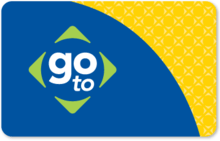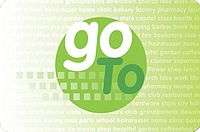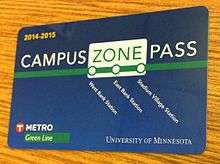Go-To card
The Go-To card is a contactless smart card used to pay fares for bus, light rail, and commuter rail lines operated by Metro Transit and other transit agencies in the Twin Cities area of Minnesota. The system has significantly sped up boardings on area buses while alleviating wear and tear on existing ticket machines and fare boxes. The old magnetic strip reading machines were weather sensitive and could not be placed out in the elements like at the Hiawatha Line light rail stations.[1]
 Current Go-To card design | |
| Location | Minneapolis–Saint Paul, Minnesota |
|---|---|
| Launched | 2007 |
| Technology | |
| Operator | Cubic Transportation Systems |
| Currency | United States dollar ($400 maximum load) |
| Validity | |
| Retailed |
|
| Variants |
|
| Website | www |

The Go-To card went into full operation in early 2007.
Problems and delays
The Go-To card was originally meant to go into service in September 2003 and become the first such system in the United States, but technical difficulties delayed introduction.[2] Cubic Transportation Systems, Inc. worked under a contract valued at $16.4 million, but Metro Transit stopped payment at $9.4 million in May 2003 when it became apparent that the rollout would be behind schedule.[1][3]
Cubic Transportation Systems initially promoted this system as the first contactless smart card installation in the country, but since introduction was delayed, at least one other system in the U.S. went into use ahead of the Go-To card. While traditional smart card systems require the card to be swiped through or inserted into a reader, the Go-To card requires a passenger to tap it against the reading device. This reduces mechanical wear dramatically, and removes the need for readers to be hardened against the sometimes cold and wet climate of Minnesota. Ticket machines on Metro Transit's Blue Line were designed with the Go-To card in mind.
Before this system was sent into full release, some Metro Transit employees and selected area riders were part of a test program, started in the latter half of 2004, using the cards as they go about their daily business. In November 2004 after five months of service, Metro Transit's general manager stated that the devices only achieved 20% reliability.
Cubic said that the issues that were originally delaying introduction were software problems. Frequently, either the reader or the card did not properly detect when it has been used. Software for the central computer system, which handles synchronization and how funds are replenished, was not fully operational[4] until late April 2005. In March 2006 Metro Transit sent Cubic a letter of default demanding a plan to correct issues with the 2 and a half year delayed system.[5]
The underlying technology is Philips' MIFARE system, implementing the ISO/IEC 14443 (Type A) standard.
Full service
In November 2005, Metro Transit allowed 18,000 trial users to begin using the Go-To card system, with hopes of rolling out the cards to all users by the fourth quarter of 2006.[6]
On November 15, 2006, Metro Transit unveiled the Go-To card for 2,500 users to use during a trial period lasting until January 31, 2007. By April 2007, Go-To cards were being sold to the general public at Metro Transit stores. It is also possible to buy and refill cards at other locations that sell transit passes, such as some local grocery stores.
U-Pass
The Metro Transit U-Pass program is a discounted transit pass sold only to University of Minnesota students or employees taking at least one credit of courses. The pass is purchased each semester, is only effective for one semester, and has a mandatory $19 (as of Spring 2013) transportation fee not included with the actual cost of the pass. The University of Minnesota switched to the Go-To card in 2007 which allows for semester renewal up to six years.[7]
Campus Zone Pass

The Campus Zone Pass allows free travel between the West Bank, East Bank, and Stadium Village Green Line light rail stations. The card is free to registered students, faculty, and staff of the University of Minnesota Twin Cities.[8]
Metropass
The Metropass is a transit pass for trains and buses sold at a discounted rate to employees purchased by local companies.[9]
College Pass
The Go-To College Pass is a pass good for unlimited bus and train rides per semester in the Minneapolis-St. Paul area sold at a discounted rate to eligible college and university students. Participating schools include Anoka-Ramsey Community College, Anoka Technical College, Augsburg University, Aveda Institute, Bethel University, Century College, Concordia University, Dunwoody College of Technology, Hamline University, Hennepin Technical College, Inver Hills Community College, Macalester College, Metropolitan State University, Minneapolis Business College, Minneapolis College of Art and Design, Minneapolis Community and Technical College, Normandale Community College, North Central University, North Hennepin Community College, Northwestern Health Sciences University, Saint Mary's University of Minnesota, St. Catherine University, Saint Paul College and University of St. Thomas.[10]
References
- Blake, Laurie (December 22, 2004) "`Go To' card runs into a few speed bumps - Metro Transit's frequent-ride card should debut soon" Star Tribune
- "Minneapolis / St. Paul becomes first U.S. transit authority to implement Philips' contactless smart card technology". Smart Card Alliance. Archived from the original on September 25, 2006. Retrieved December 29, 2012.
- Sullivan, Jack (July 6, 2004) "SMART CARDS NEED STUDY - COMPUTER GLITCHES HOLD UP NEW SERVICE" Saint Paul Pioneer Press
- LASZEWSKI, Charles (October 6, 2005) "PASS RIDERS TO TEST FARE SYSTEM - AFTER A BAD START, GO-TO SMART CARDS GET DEBUGGED" Saint Paul Pioneer Press
- LASZEWSKI, Charles (March 29, 2006) "TRANSIT FARE CARD HOBBLED BY KINKS - METRO TRANSIT, VENDOR CLASH OVER LONG-DELAYED SYSTEM" Saint Paul Pioneer Press]]
- Blake, Laurie (October 7, 2005) "UPDATE - Transit fare card set to go for tests" Star Tribune
- "U-Pass". University of Minnesota. Retrieved December 29, 2012.
- "Campus Zone Pass". University of Minnesota Parking and Transportation. Fall 2014. Archived from the original on 12 November 2014. Retrieved 11 November 2014.
- "Metropass". Metro Transit. Retrieved December 29, 2012.
- "College Pass Schools". Metro Transit. Retrieved April 21, 2019.